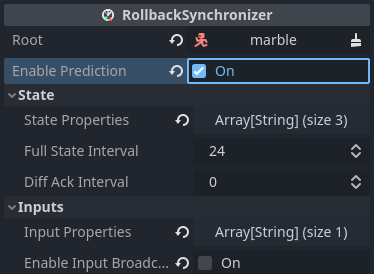Predicting input
Whenever clients send their inputs, it takes some time to arrive. From there, it also takes time for the updated game state to arrive to clients.
This means that the server never knows the client's current input, only the input from a few ticks ago - depending on network latency. Other clients are even more behind, as they also need to wait for the server to broadcast the updated game state.
Another trick netfox enables to hide this latency is input prediction.
About prediction
By default, nodes are only simulated for ticks that we currently have enough information for - i.e. the input for the current tick. If there's no input, the node simply isn't simulated, as we can't know what the player intended to do.
But, what if we do know? Or what if we can make a reasonable guess?
For example, in driving games, it is a safe assumption that if the player was going full throttle three ticks ago, they are still going full throttle.
It is important to consider the last received input's age. The more time passes, the harder it is to reasonably predict the player's inputs.
Prediction allows users to implement similar, game-specific predictions.
Implementing input prediction
NetworkRollback provides the following signal:
signal after_prepare_tick(tick: int)
This is emitted during rollback, after the input and state is applied for the tick about to be simulated. This is the phase where input prediction may happen.
Firstly, call RollbackSynchronizer.is_predicting(), to check if any
prediction needs to be done. If none, input can be left as-is, without
predicting.
You may also check if there's any known input for the current tick that we
can base our prediction off of. This is done by calling
RollbackSynchronizer.has_input().
For the actual prediction, consider the age of the last known input. This is
obtained by calling RollbackSynchronizer.get_input_age(), which will return
the applied input's age in ticks.
To put all of this into practice, see the following snippet:
extends BaseNetInput
var movement: Vector3
var confidence: float = 1.
@onready var _rollback_synchronizer := $"../RollbackSynchronizer" as RollbackSynchronizer
func _ready():
super()
# Predict on `after_prepare_tick`
NetworkRollback.after_prepare_tick.connect(_predict)
func _gather():
# Gather input
movement = Vector3(
Input.get_axis("move_east", "move_west"),
Input.get_action_strength("move_jump"),
Input.get_axis("move_south", "move_north")
)
func _predict(_t):
if not _rollback_synchronizer.is_predicting():
# Not predicting, nothing to do
confidence = 1.
return
if not _rollback_synchronizer.has_input():
# Can't predict without input
confidence = 0.
return
# Decay input over a short time
var decay_time := NetworkTime.seconds_to_ticks(.15)
var input_age := _rollback_synchronizer.get_input_age()
# **ALWAYS** cast either side to float, otherwise the integer-integer
# division yields either 1 or 0 confidence
confidence = input_age / float(decay_time)
confidence = clampf(1. - confidence, 0., 1.)
# Modulate input based on confidence
movement *= confidence
In this example, a confidence value is calculated based on the input age. This is then used to gradually fade out the input, as if the player slowly let go of the controls.
Make sure to consider the specifics of your game and tailor your input prediction strategy to the game's needs. Depending on the game, you may even opt out of prediction.
Impossible predictions
In the example above, a confidence value of zero means that input simply can't be predicted currently. This usually happens when the input is too old to use for prediction.
In this case, call NetworkRollback.ignore_prediction(target). This lets
netfox know that the target node - usually self - can't be predicted. Its
simulated state will not be recorded for the current tick.
To see this in practice:
func _rollback_tick(dt, _t, _if):
if is_zero_approx(input.confidence):
# Can't predict, not enough confidence in input
_rollback_synchronizer.ignore_prediction(self)
return
# ... run simulation as usual ...
If there's not enough confidence in the input, ignore_prediction is called,
and we return early.
Note
NetworkRollback.ignore_prediction() can be called for multiple nodes from
the same script. This is useful in cases where a single script drives
multiple nodes, like an FPS controller updating the whole body's position
and the head's rotation independently.
Configuring prediction
Running the game in its current state would result in no changes - prediction
is off by default. It can be toggled separately for each
RollbackSynchronizer.
To enable, check Enable Prediction in the RollbackSynchronizer's
configuration:

With this configured, RollbackSynchronizer will simulate all the nodes it
manages even for ticks that it doesn't have input for.
Example project
To see all of the above as one cohesive project, see the Input prediction example.